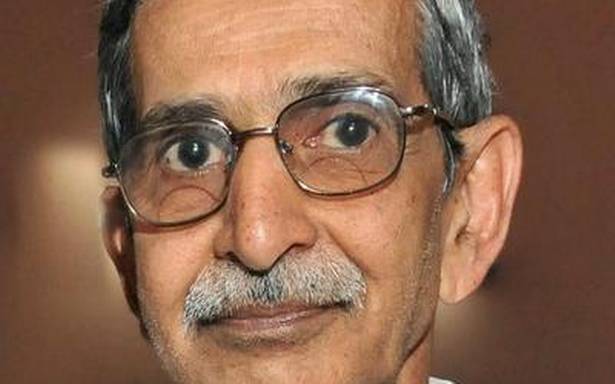June 5 marks the 36th death anniversary of the legendary Kannada film director, Puttanna Kanagal. His films such as Belli Moda, Kappu Bilapu, Gejje Pooje, Sharapamjara, Sakshatkara Nagarahaavu and Ranganayaki are considered classics. Ranganayaki and Yedakallu Guddadamele put women centre-stage with the latter film dealing with the sexual desires of a woman whose needs were not met by her husband. His concepts were bold, profound and dealt with complex relationships.
While his films featured established actors such as Srinath and Ramakrishna, Sridhar made his debut in a Puttanna Kanagal film. The actor and Bharatantaya dancer was 22 and studying engineering when Puttanna approached him for a role in Amruta Ghalige. Most people would have jumped at the offer to work with the renowned director but the academically inclined Sridhar asked for a week to think about the offer.
Shock and awe
“I was shocked,” Sridhar said with a laugh. “We had no connection with the film industry. I was in my final year of engineering, and was involved in theatre and dance. I was playing Arjuna in the dance drama, Chitrangada. We were performing in Town Hall and after the show I was informed that Puttannaji had sat through the performance. I was pleasantly surprised when I got a call from him a few days later. When I asked for a week’s time, he was surprised. I was huge fan and when we met, instead of discussing the role, we got into an intense discussion of his earlier films. He kept pacing up and down while I spoke animatedly. He later revealed to me that he was studying my expressions, body language and ability to approach the role he had in mind for me.”
Eyes right
Before the shoot, Puttanna asked Sridhar to look directly at the sun a few times a day. “I later understood the exercise was to strength my eyes. Those days we used heavy reflectors and the actor would crinkle his eyes or blink.”
Sridhar’s first shoot was at a temple close to Sagara with the leading lady, Padma Vasanthi. “It was a prayer scene, followed by the song, ‘Hindustanada Yendu Mariyada, Bharata Ratnavu.’ Since it was similar to classical dance, and I was from a theatre background, it was easy for me to slip into the character’s skin. After this we worked on the marriage scene, which was intense. Puttanna told me what he wanted and I spent hours thinking of the character and emotions. Once the shot was done, Puttanna hugged me.”
The same day the unit got to know that Padma had won the State Award for her role in Manasa Sarovara. Puttanna arranged a celebration and told Sridhar he expected him (Sridhar) to win the award for Amruta Ghalige the next year. “Till date, those words are bigger than any award or recognition I have ever received.”
Be prepared
With Puttanna, Sridhar says, you had to be prepared for last minute changes. “He was constantly creating and visualising. And as an actor, one had to be prepared to explore every emotion. Even when I was done with my shot, I would sit beside him observing and make notes in my diary. In between shots, he would ask me, ‘Do you see that effect on the camera? That was brought about by creating this shadow effect here.’ I was in awe of him. He would be euphoric while directing. I am yet to see that kind of passion in anyone else. He was a director on set, but once pack-up was announced, he would take on the role of a parent.”
Mantra for perfection
Likening working with Puttanna to a guru-shishya relationship, Sridhar says he would not stop till the actors had given their best and he was satisfied. “This was extended towards the crew as well. BS Basavaraj was the DOP for Amruta Ghalige. For the wedding scene, Puttanna wanted a particular blue light to reflect on my face. Basavaraj had to climb a tree, fix lights with blue shades in such a manner that the particular shade Puttanna wanted to fall on my face was achieved.”
Lot of thought went into choosing locations, Sridhar says. “The locations became characters. If you see a tree, or a rocky range, it echoes the mood of the film. That was his speciality. No matter how much I speak, I will never be able to do justice to his genius. It is like only when you stand in front of Mount Kailash, will you be able to understand its grandeur. No amount of description will give you that experience.”
Memoirs in black and white
Aswathanarayana was Puttanna’s personal photographer capturing every moment on his camera. “I was lucky to spend so many years with a man of his intellect and stature,” he says. “I first met Puttanna in 1965, on the sets of Belli Moda. I was 19 years old and learning photography. The photographer who was supposed to be on the sets could not make it and I was asked to step in.”
From that day till 1985, Aswathanarayana was a constant with Puttanna. “It was with Belli Moda that Puttanna became a legend. He was adept in every aspect of filmmaking and this helped him extract the best work from his cast and crew. People say he favoured woman-centric themes. That was just one part of his oeuvre. His films covered almost every aspect of the human heart, mind and emotion. He would tell me every picture I took should also tell a story, depict an emotion. He became my teacher and the set was my school. He was very supportive of a still photographer like me, which is rare.”
Puttanna shared the images Aswathanarayana clicked with the media and for film promotions.
“When actors worked with Puttanna, their performance was elevated to a different level. Puttanna was capable of bringing out the best in each one of us.”
Source: Read Full Article

